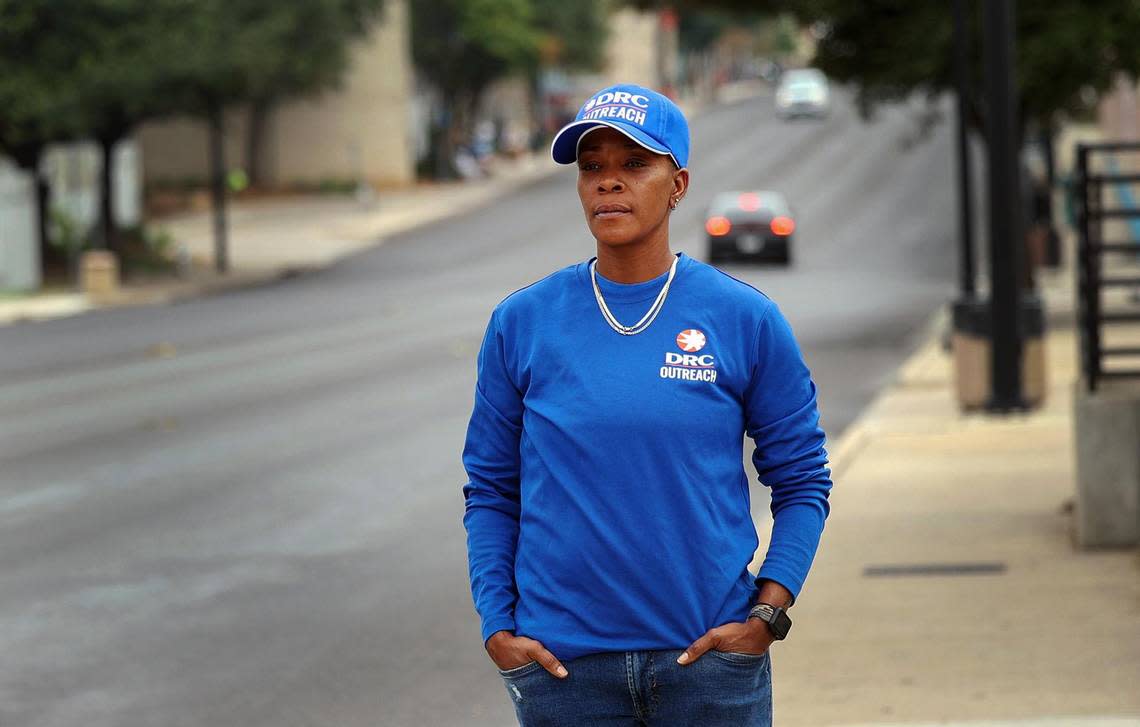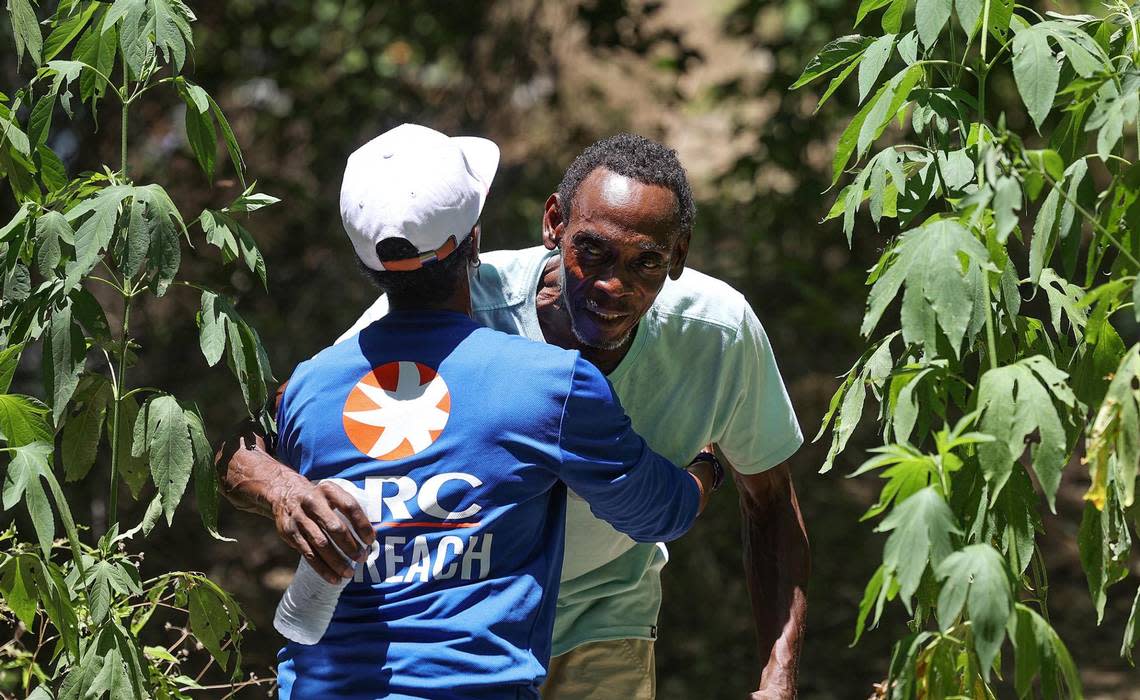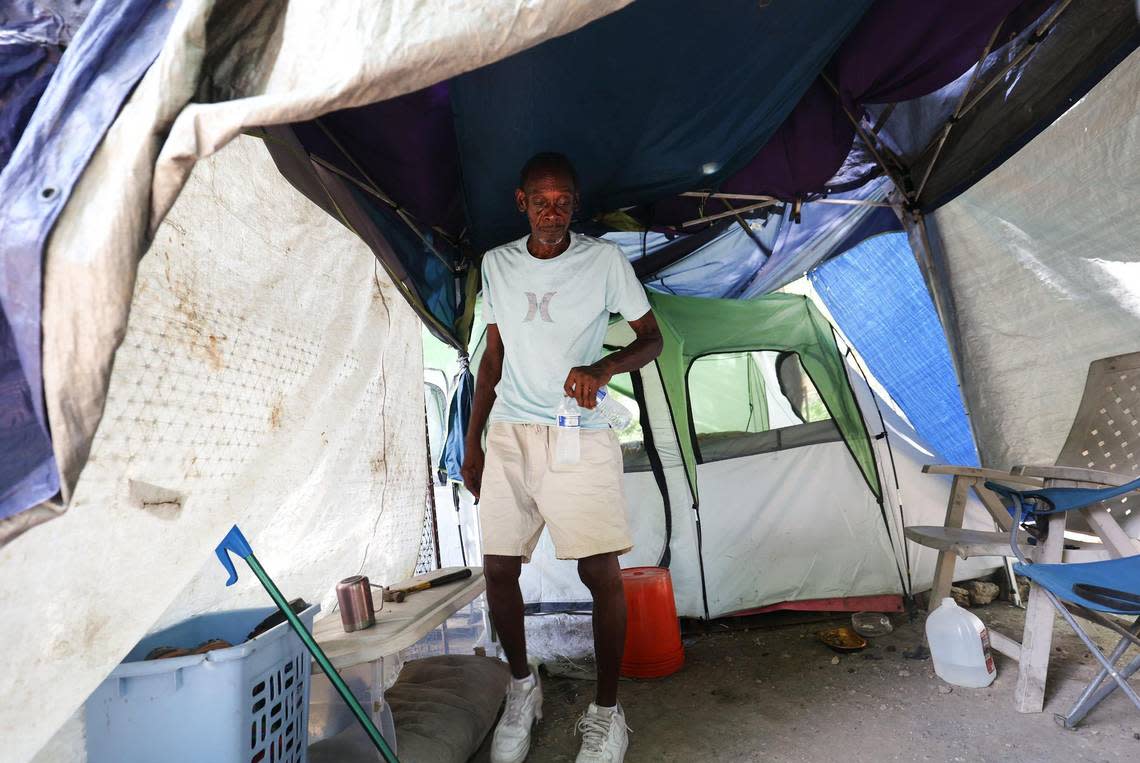This summer was deadly for Fort Worth’s homeless. ‘How are we going to respond?’
When Fatimah Robinson went looking for Gary Randle, she would often clamber over tree roots and up small hills, yelling out his nickname loud enough so he could hear her.
“Twin! Twiii-in!” she would call.
Robinson, an outreach worker with DRC Solutions, visited with Randle at least once a month. Randle was homeless, and camped outdoors in a wooded area off of U.S. 287, near the Historic Southside neighborhood of Fort Worth. Sometimes, he would wander from his campsite, or be talking with one of his neighbors, and Robinson would have to belt his nickname a few times before they found each other.
Robinson and Randle referred to the other as “twin” because of their similar personalities.
On a Tuesday in August, Robinson got a voicemail from someone she didn’t know. It was a cousin of Randle’s. She told Robinson that her twin had died.
“They said ‘I want you to know, Gary passed away,’” Robinson said. “‘I don’t want you going out there and yelling ‘Twin!’”

Randle is one of multiple people living unsheltered who have died this summer, part of a worrying trend for the doctors, social workers, and other service providers who work primarily with Fort Worth’s homeless. Joel Hunt, the director of the street medicine team at JPS Health Network, said at least 40 people who were unsheltered have died since July 1, according to his team’s data. About 80 or 90 homeless people die in Tarrant County in a typical year, Hunt said.
“I’ve never experienced this much death repeatedly, and not knowing the reasons why,” Hunt said.
What’s causing the unusual surge in deaths is unclear, and even the exact number of homeless people who have died is still unknown. Hunt and his team have relied on data from the Tarrant County Medical Examiner’s Office, but some death reports are delayed as the office attempts to notify family members of the deceased. For people living unsheltered, who might be out of touch with their family, those notifications can take weeks.
Lauren King, the executive director of the Tarrant County Homeless Coalition, has also noticed the rise in deaths.
Both are waiting for more information about what might be driving this increase, to learn how they and other organizations can better respond to the homeless community’s needs.
“It is alarming,” Hunt said. “If our future is these kinds of summers, is this going to be the norm? How are we doing to respond?”
Summer outreach during extreme heat
The Star-Telegram wrote about Robinson and Randle and their bond in a July 14 article that detailed how DRC Solutions was working to reach out to hundreds of unhoused people during the extreme summer heat.
Randle died about three weeks after the article was published. The Tarrant County Medical Examiner’s Office has not determined Randle’s cause of death, but Randle’s neighbors and those who worked with him at DRC Solutions have speculated that he died from extreme heat.

On Aug. 5, the day Randle died, he had been out looking for one of his dogs, Robinson said. He and a neighbor had spent the morning searching for the dog, who had wandered away from Randle’s campsite. After hours of searching, Robinson had gone into his tent to rest. He died later that day, Robinson said.
The high on Aug. 5 was 107.
Normally, Randle would cope with the heat by sitting in a creek next to his tent, he told the Star-Telegram in July. He said he had probably passed out from the heat multiple times over his years living outside. In July, he said the constant heat of Texas summers was often exhausting. Some days it felt hard to breathe, he said.
Randle and Robinson had known each other for almost a decade. They first met when Robinson worked security at Union Gospel Mission, a nonprofit that works with people experiencing homelessness. Over time, they developed a bond, and recognized in each other a similar willfulness.

Randle moved to Texas as a refugee from Louisiana after Hurricane Katrina. He told Robinson that most of his relatives had perished in the storm or its aftermath.
Randle had lived on the streets for years. He had trouble staying in shelters, Robinson said, likely because of post-traumatic stress disorder. At one point, he had built a small shack by the railroad tracks. After the shack was destroyed, he moved to a nearby wooded area, where he built a small campsite. He lived there for at least a year before he died, Robinson said.
Randle did what he could to make the campsite a home: He hung a clothesline, where he and his neighbors could hang their clean laundry. He created a makeshift bathroom stall, so neighbors could have a little privacy. He checked on his neighbors and doted on the dogs that lived in his tent with him.
Fatality review committee
Joel Hunt, the leader of the street medicine team, treated Randle along with hundreds of other people living outdoors this summer. Hunt leads a four-person team that focuses on treating unsheltered people throughout Fort Worth and Tarrant County.
Unsurprisingly, people living outside typically grapple with a range of diseases and conditions. On average, someone experiencing homelessness has a life expectancy of about 20 years less than someone with stable housing.
Facing such odds, Hunt said he and his colleagues focus on building relationships with their patients and trying to find ways to reduce their suffering, even as they face the constant crisis of living without shelter.
Understanding exactly how living outdoors or in unstable housing can affect someone’s health can be difficult to determine, but some municipalities have tried. In Los Angeles County, local researchers found that the mortality rate among the homeless population was 2.3 times greater than the rate in the general population. The average age of death among homeless LA County residents was 51, compared to 73 in the general population, according to the report.
“Put simply, being homeless in LA County is becoming increasingly deadly,” the report concluded.
Tarrant County providers will restart a fatality review committee that had paused during the COVID pandemic, King said. The committee, which will resume meeting this year, will likely be made of representatives from the homeless coalition, JPS Health Network, Tarrant County Public Health.
The committee previously found that the average age of death in the homeless community was 52, she added. Past reviews from the committee have found that the leading cause of death among the homeless is heart disease, King said, similar to the general population. But chronic diseases typically kill people living outside much sooner than their general population. The homeless also experience high rates of homicide, suicide, accidents, and drug overdoses.
Once the committee resumes its work, both King and Hunt said they hope to have clearer answers about why more people living outside have died this summer.
“Part of the point of fatality review is to really look and see: Were there gaps in services somewhere where this person could have been caught before?” King said.
A few weeks after he died, Robinson was ready to make the first trip back to Randle’s campsite without him there. Randle’s neighbors are still living there, and have kept all his things in order. They gave Robinson a Dallas Cowboys jersey that had belonged to Randle. She hated the Cowboys, and every game day Randle would tease her about the team in his adopted hometown.
“Every time he wore a Dallas Cowboys jersey, I told him, ‘I can’t serve you today,’” Robinson joked.
But of course, she always did.
